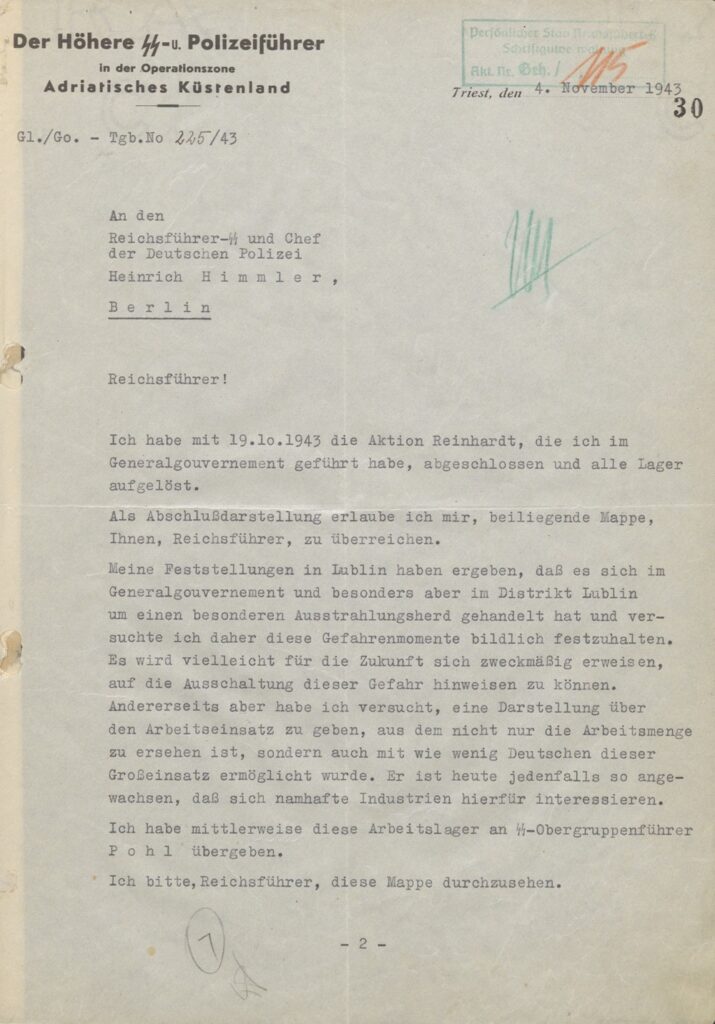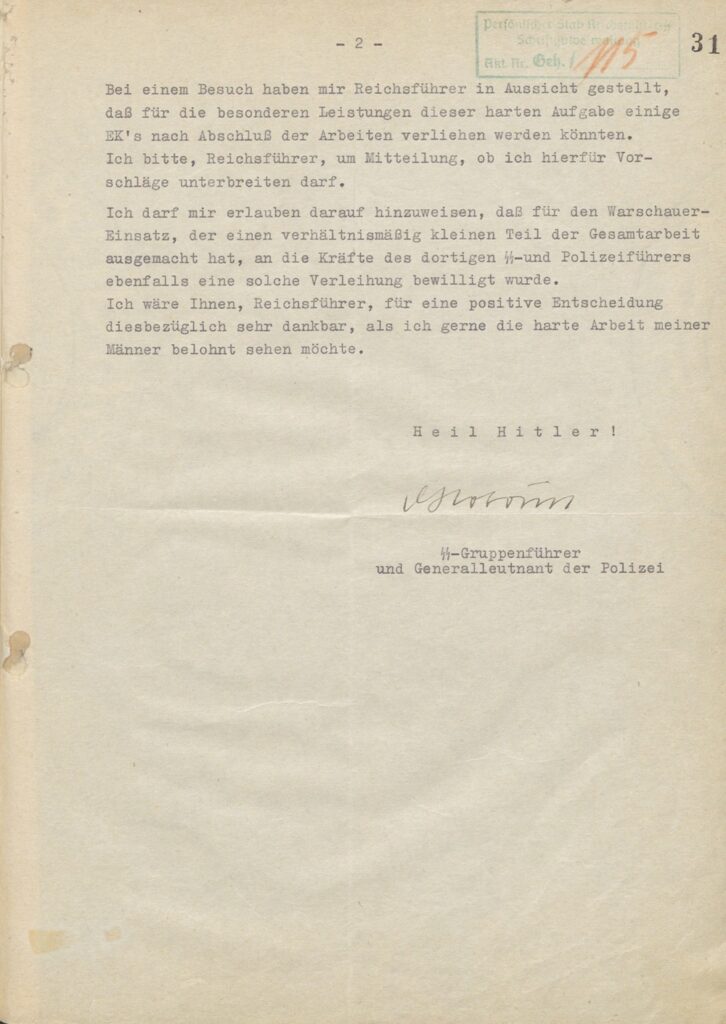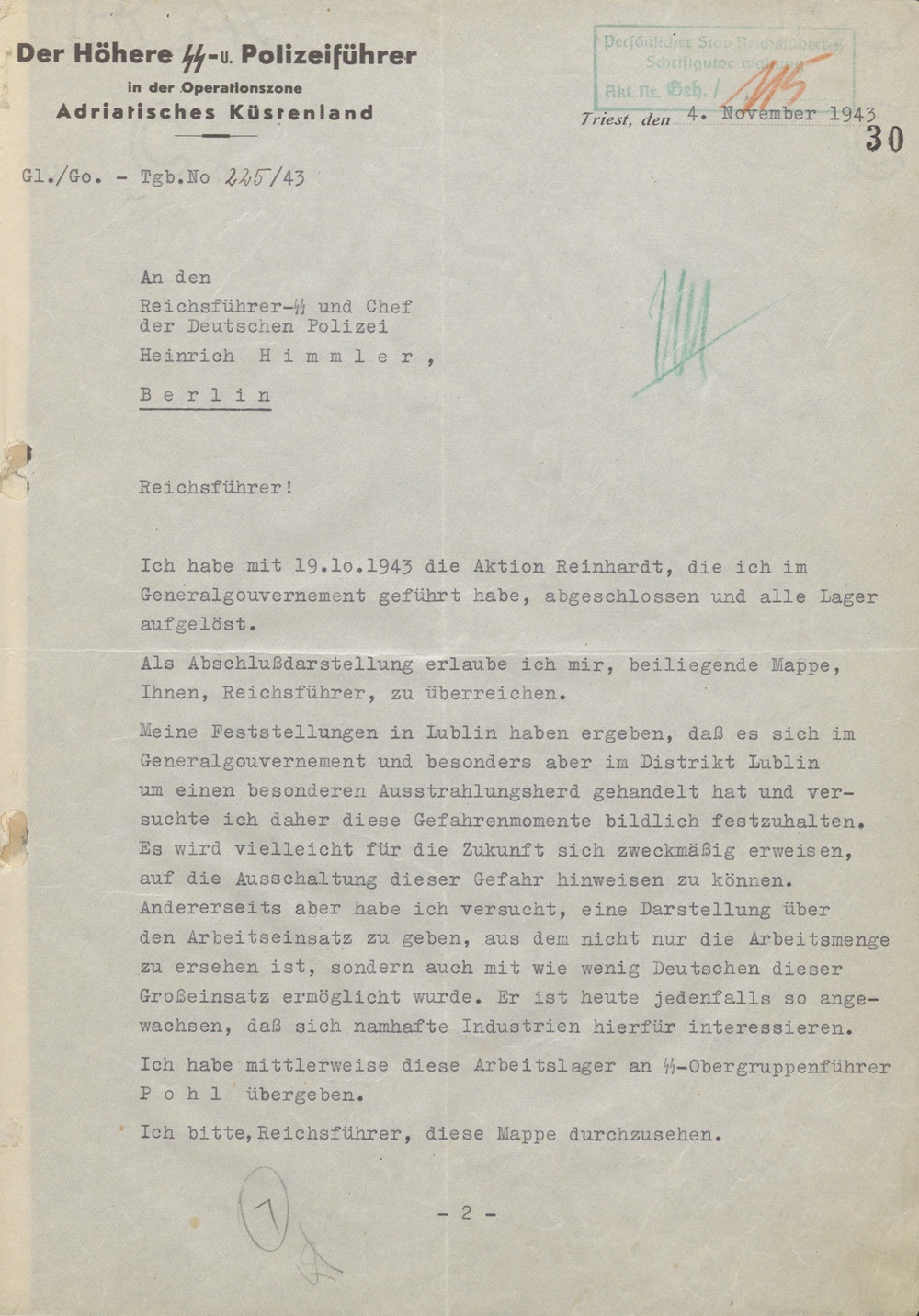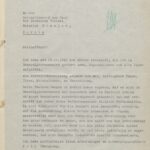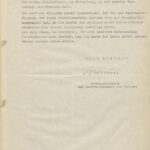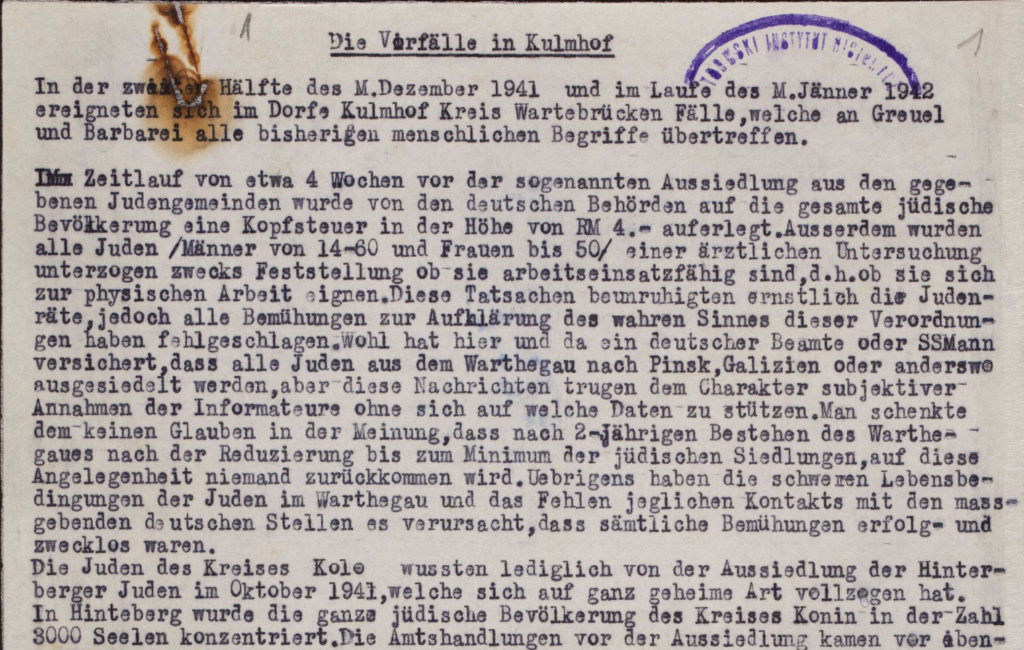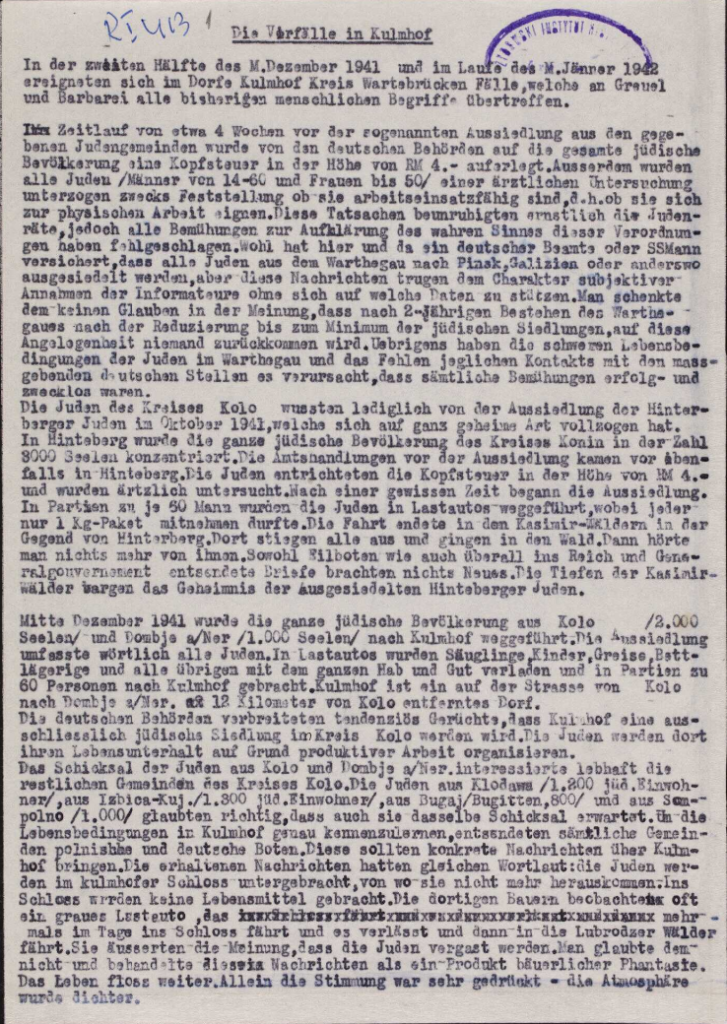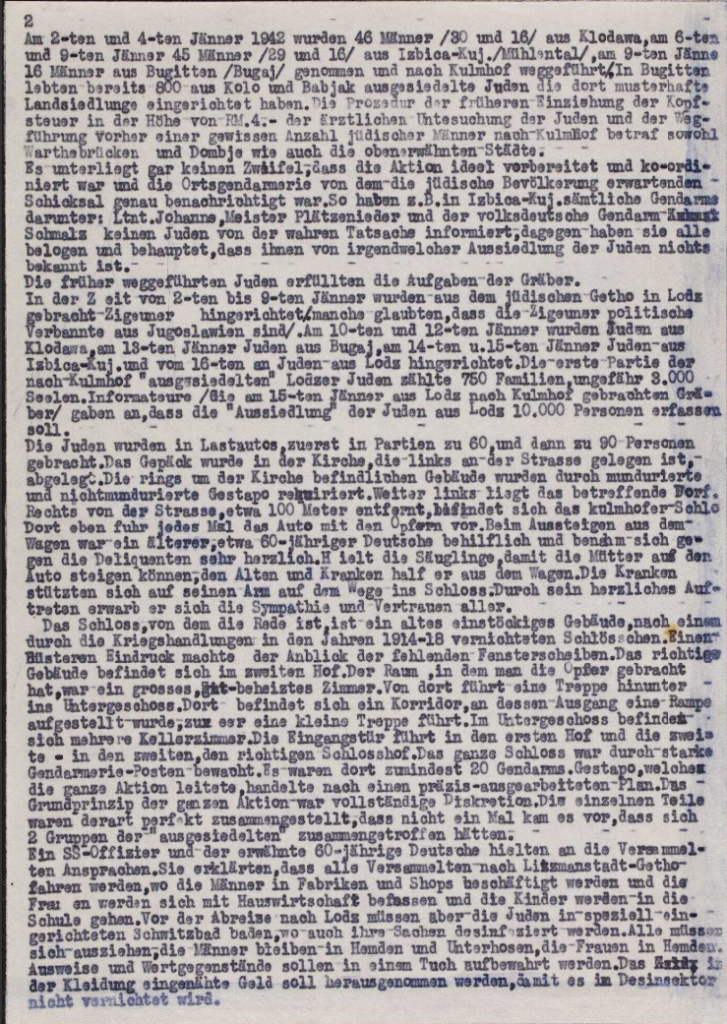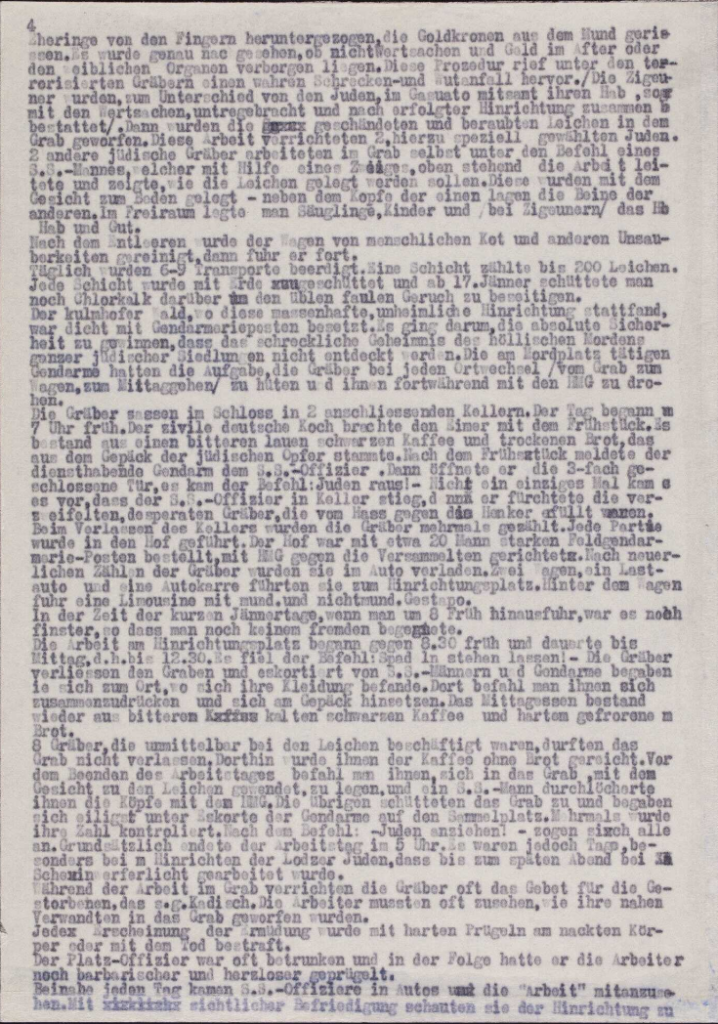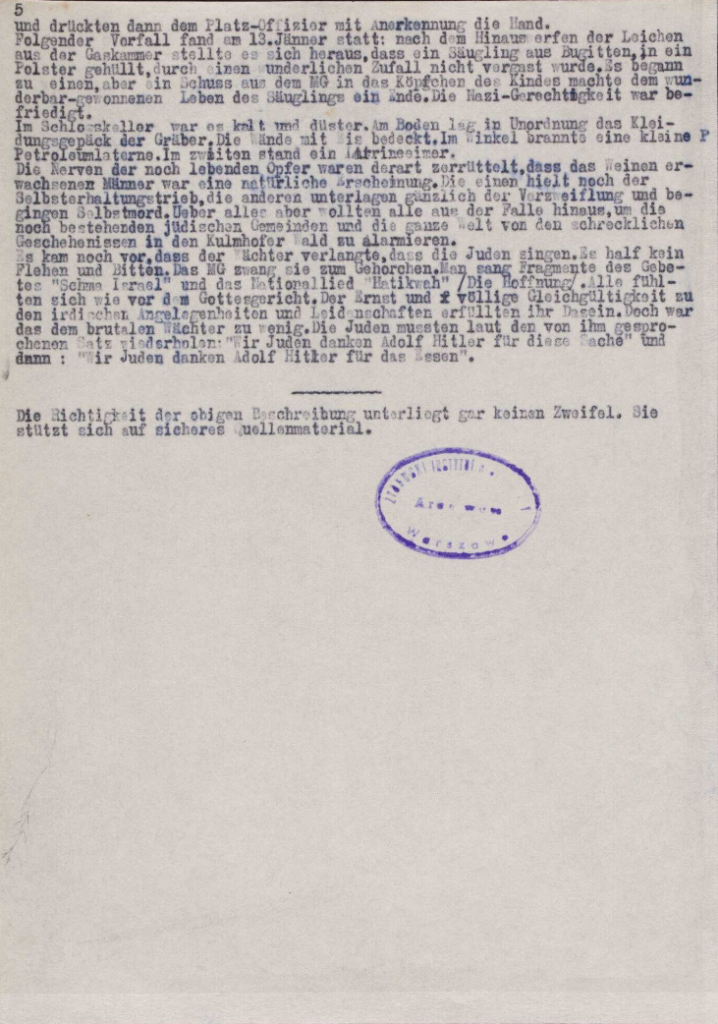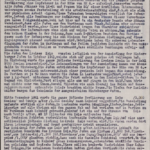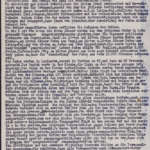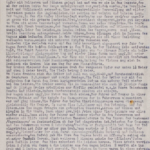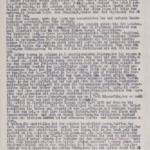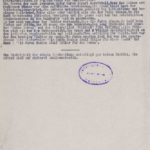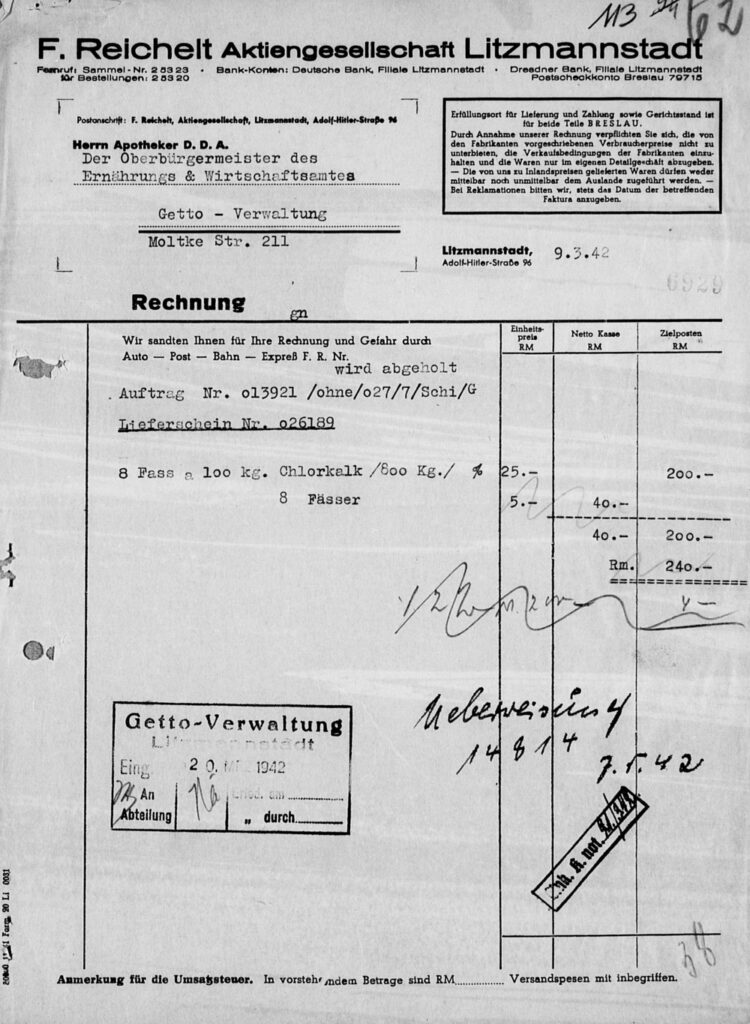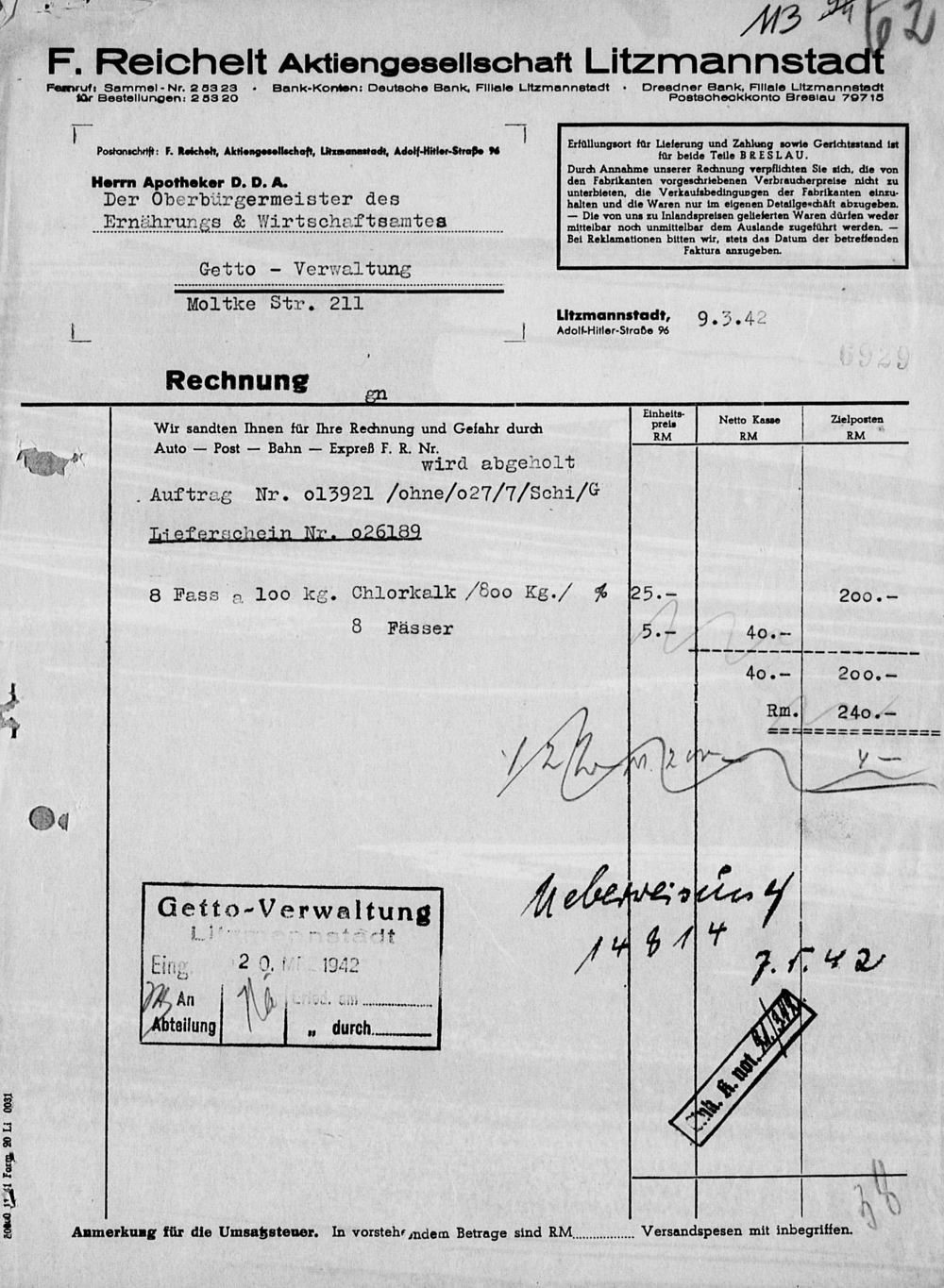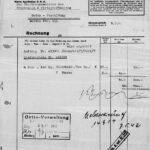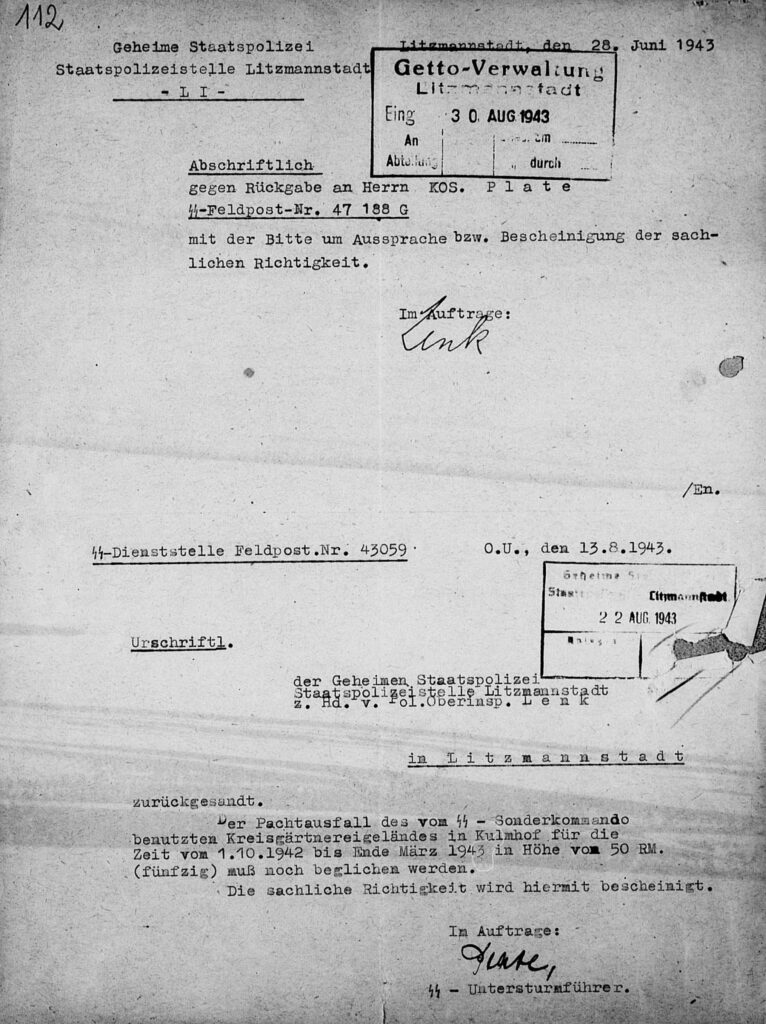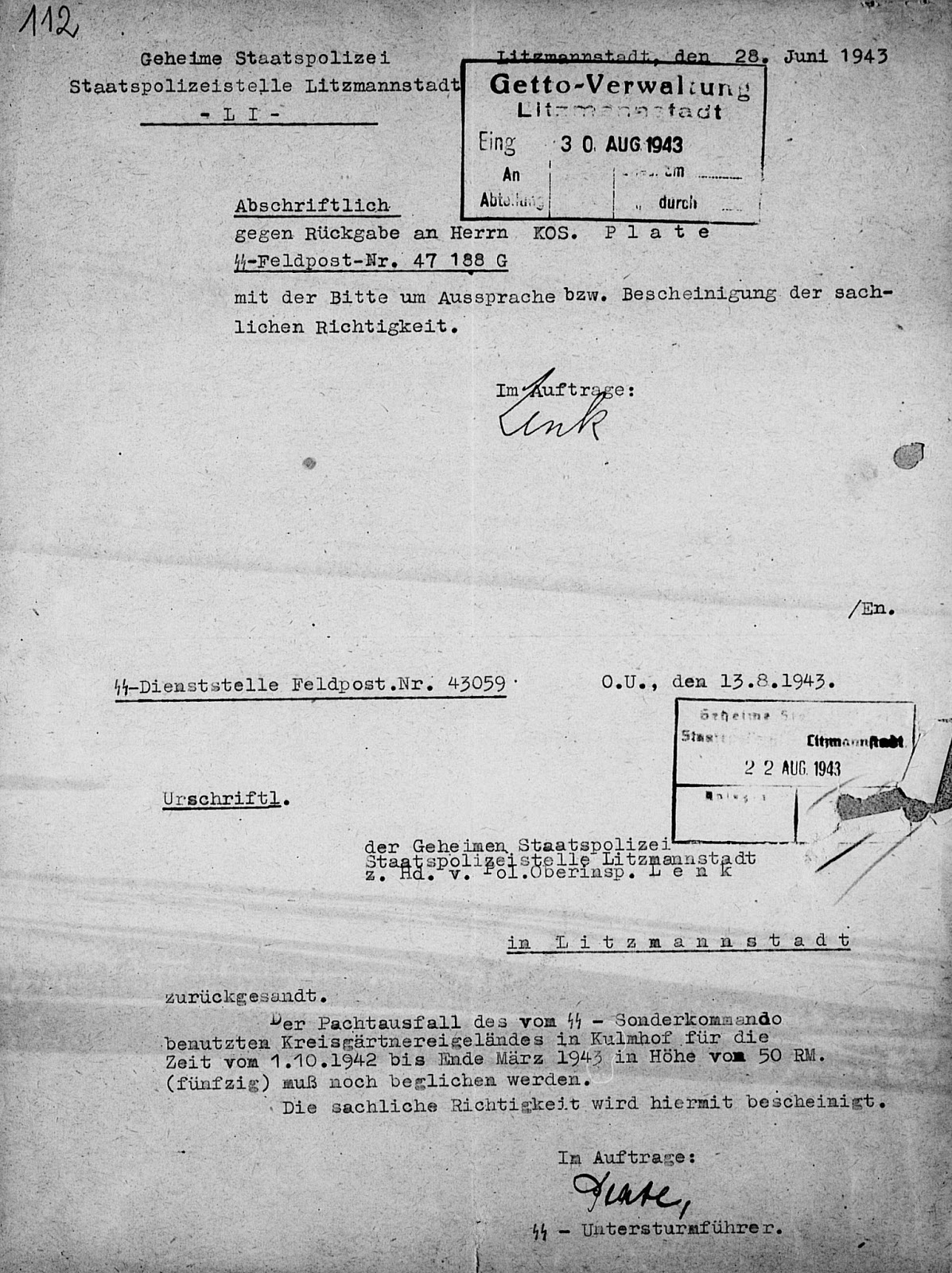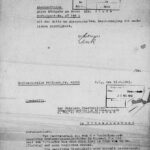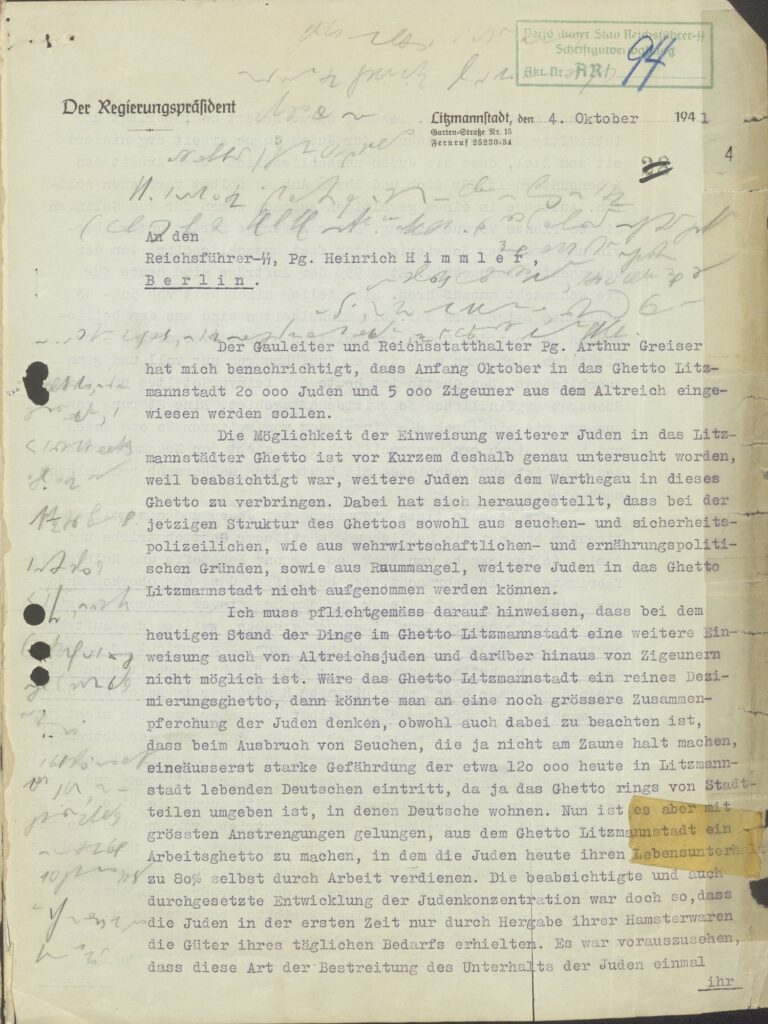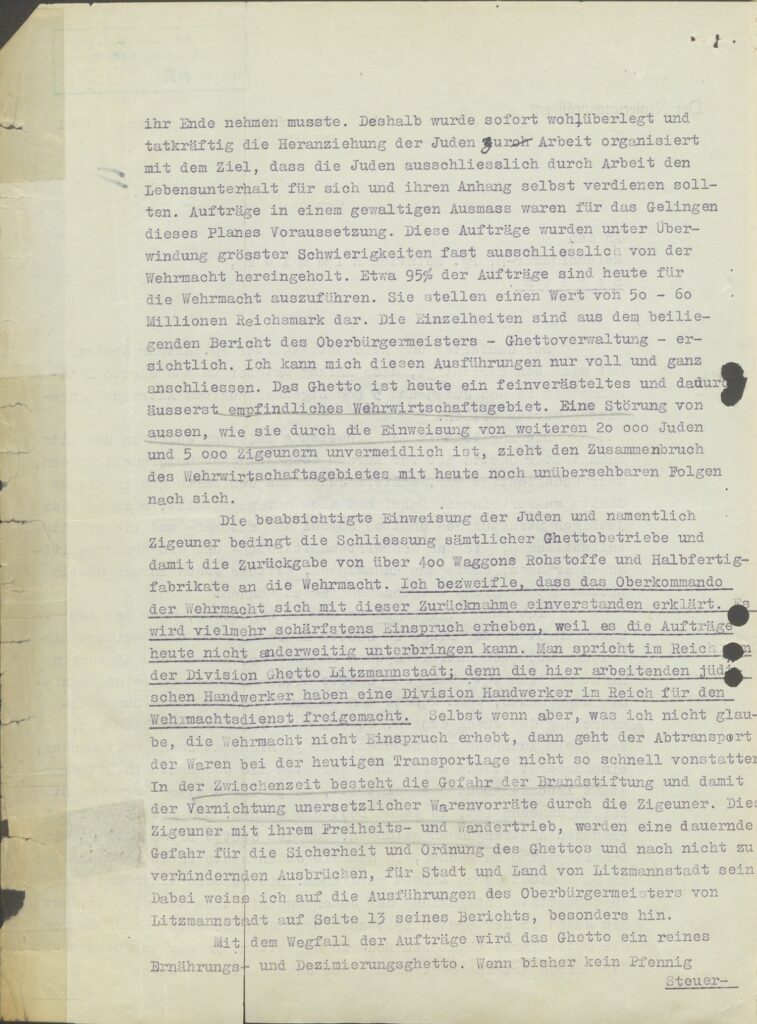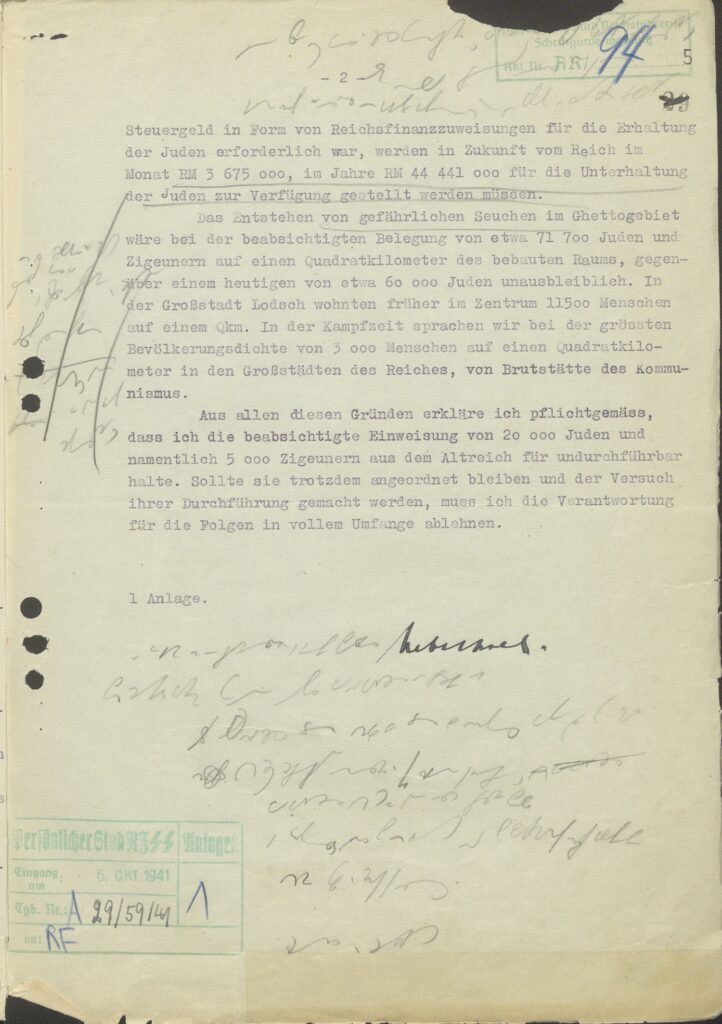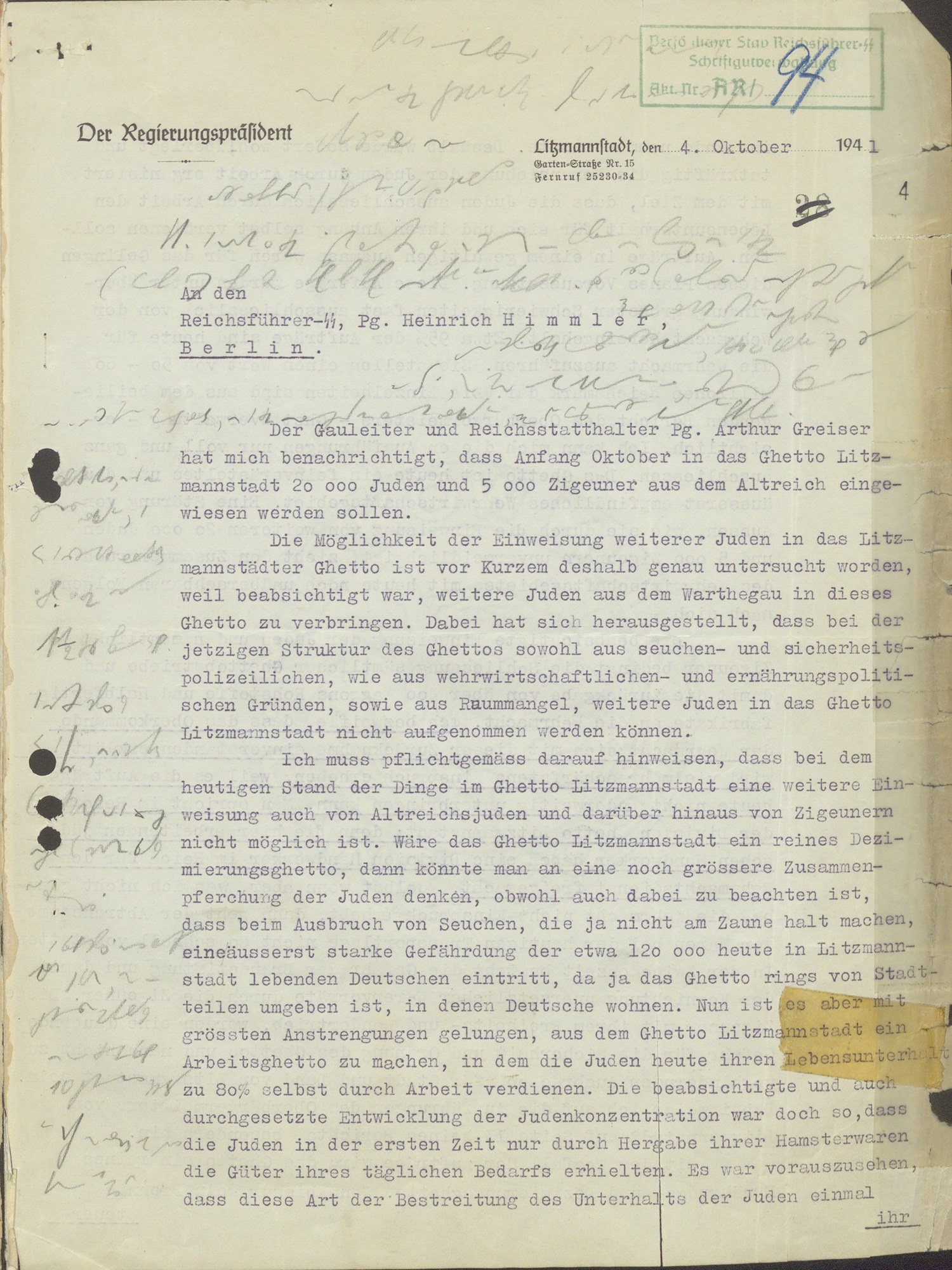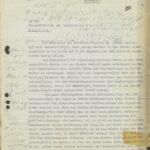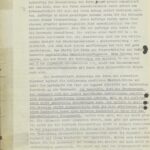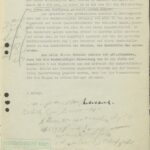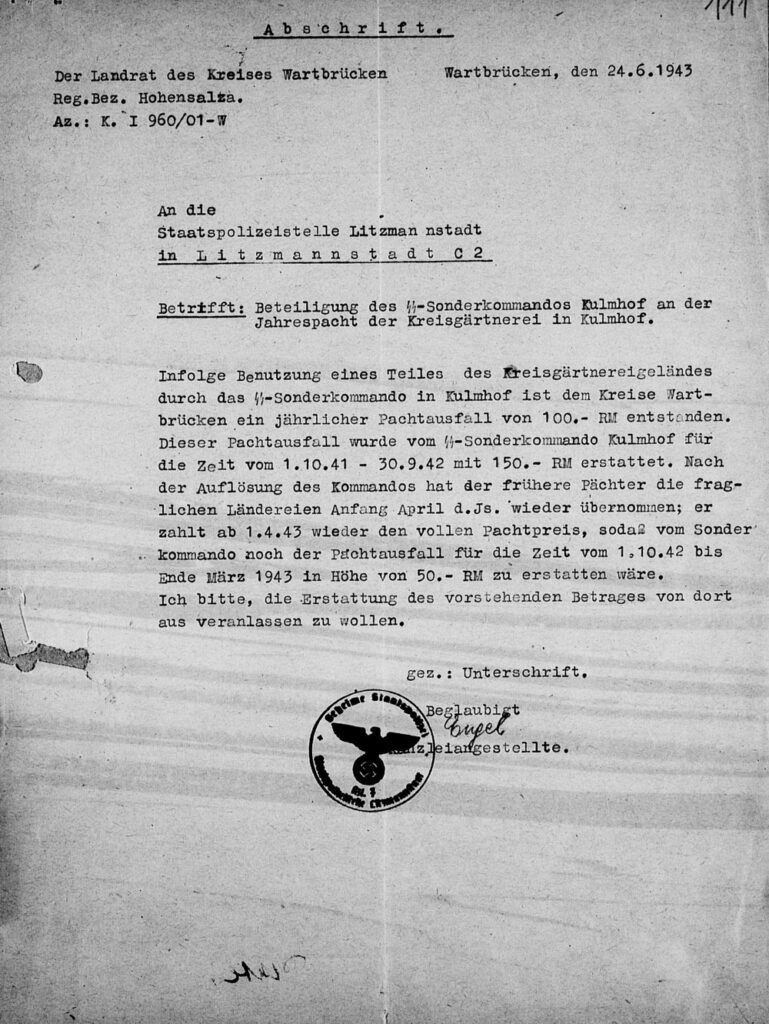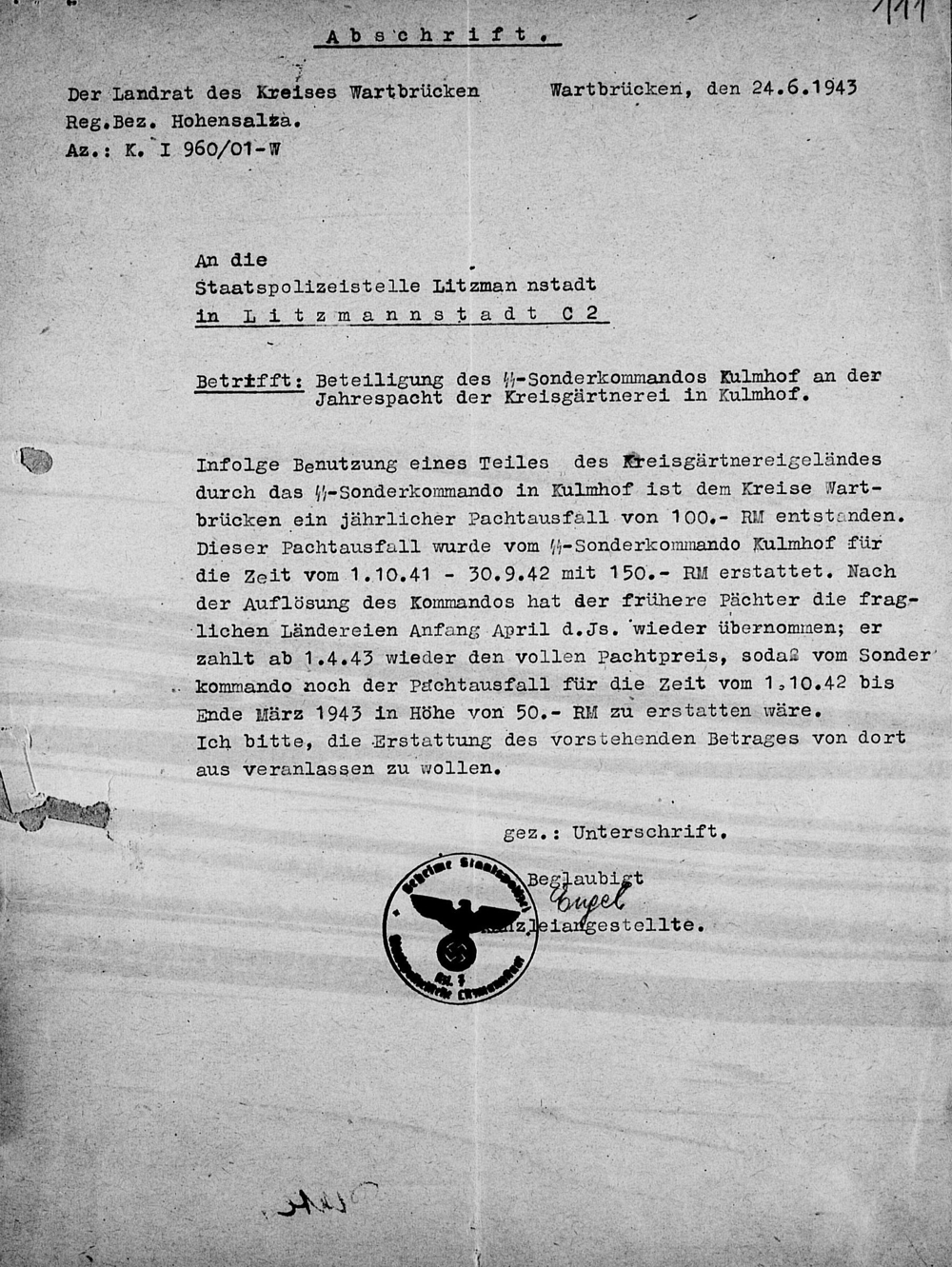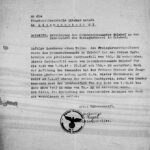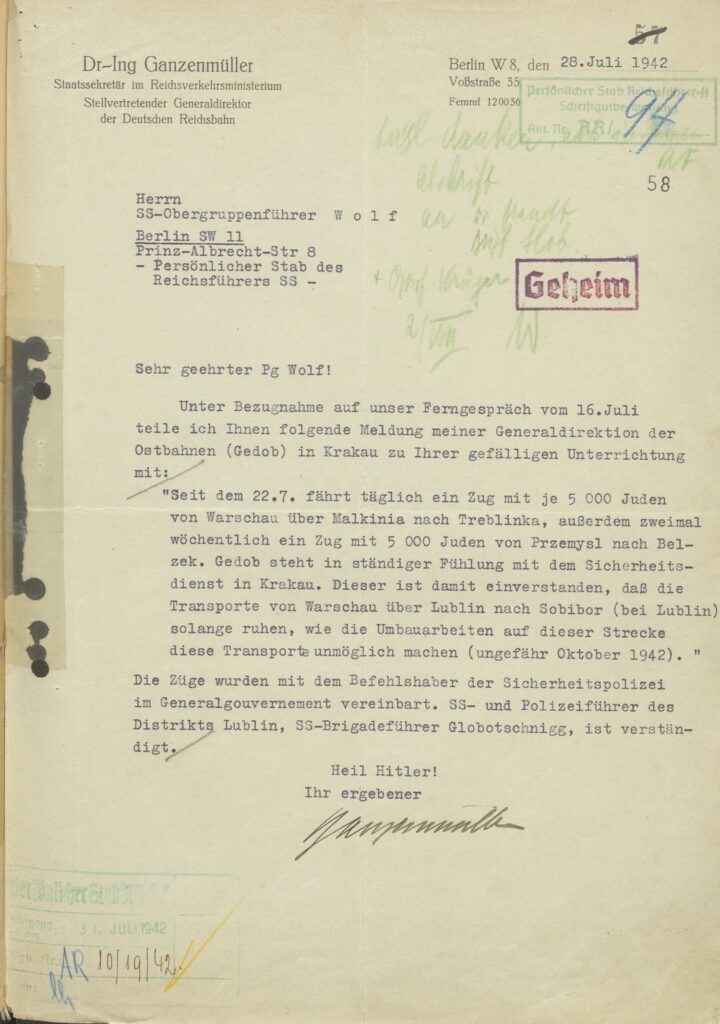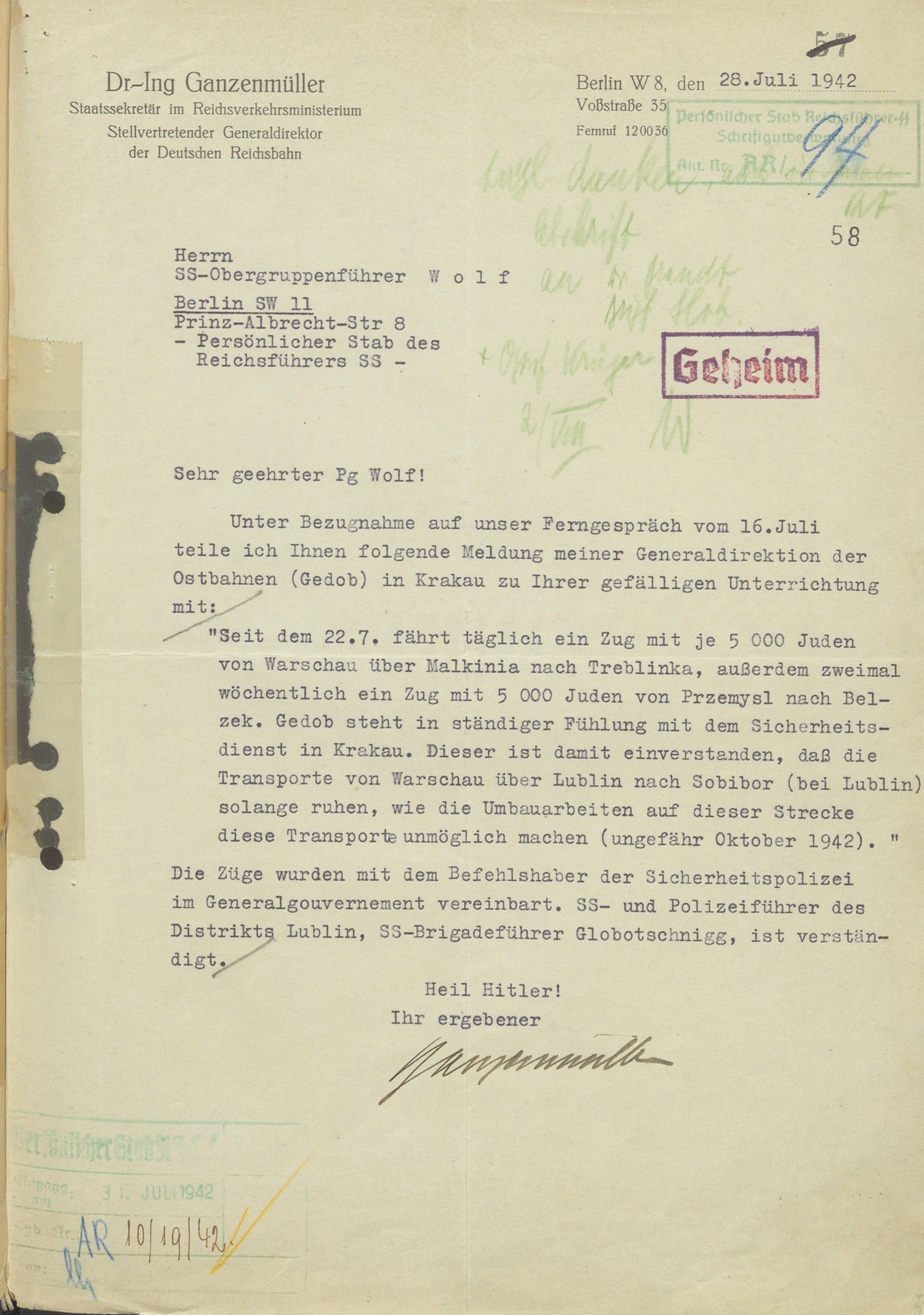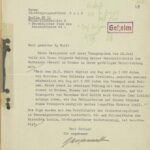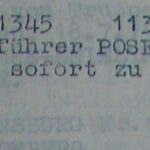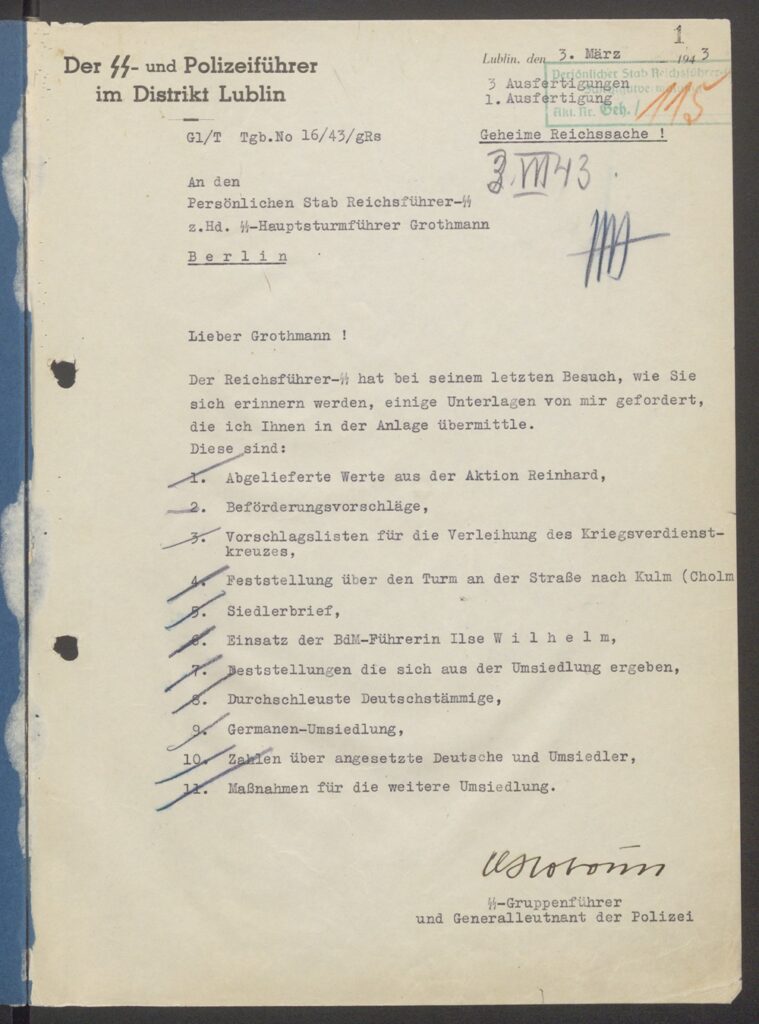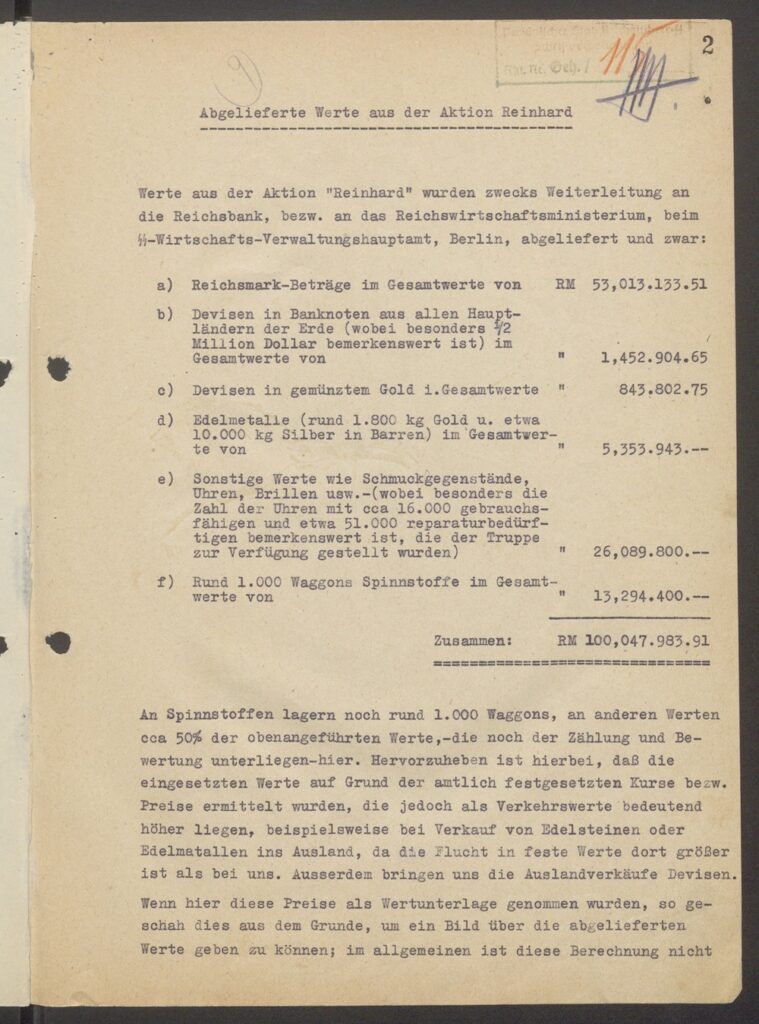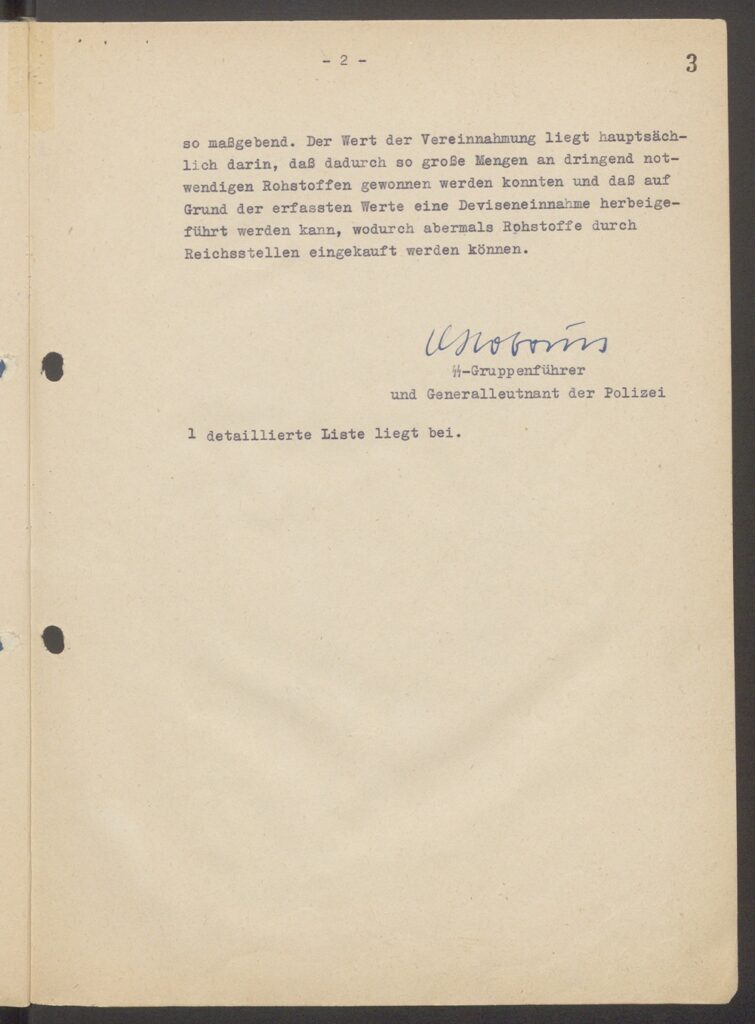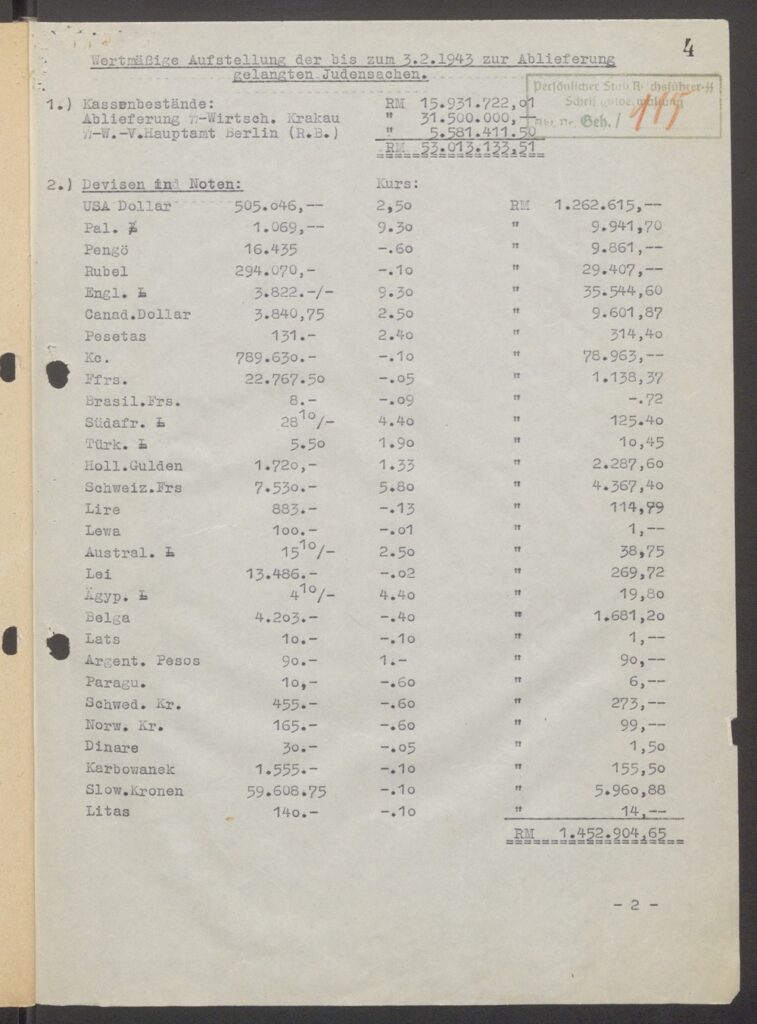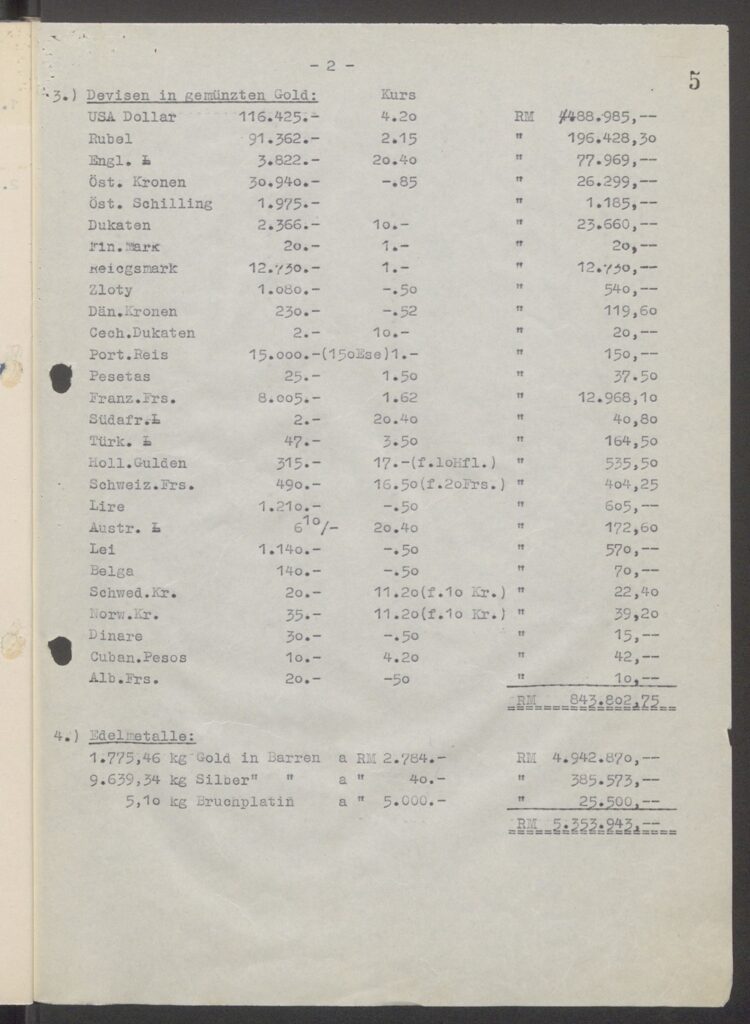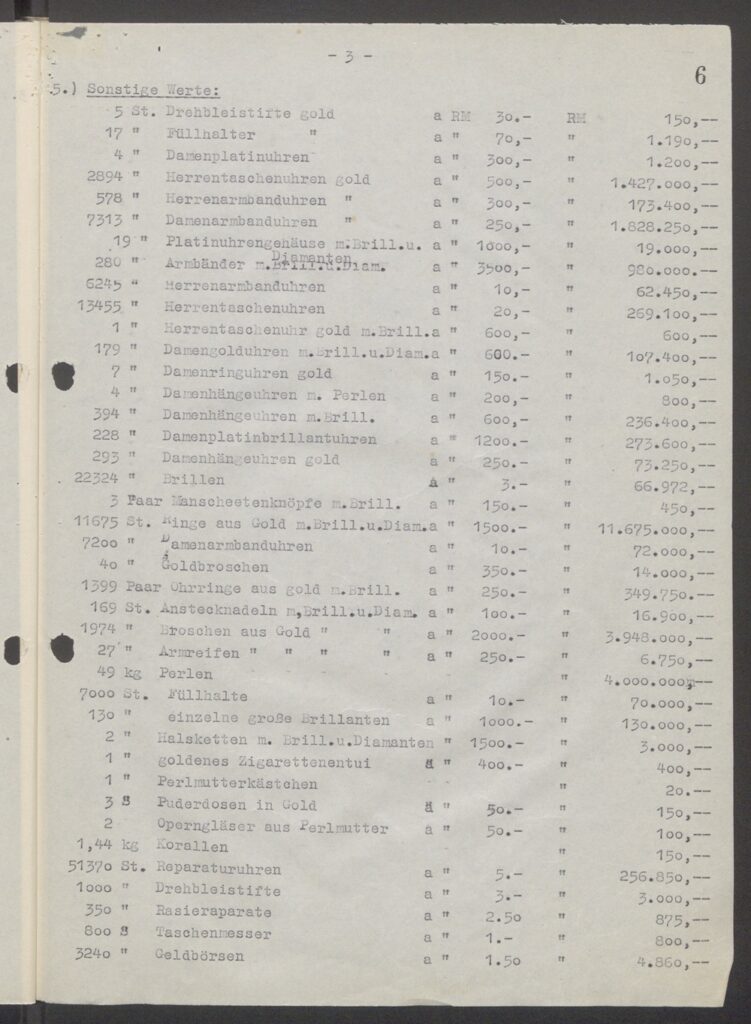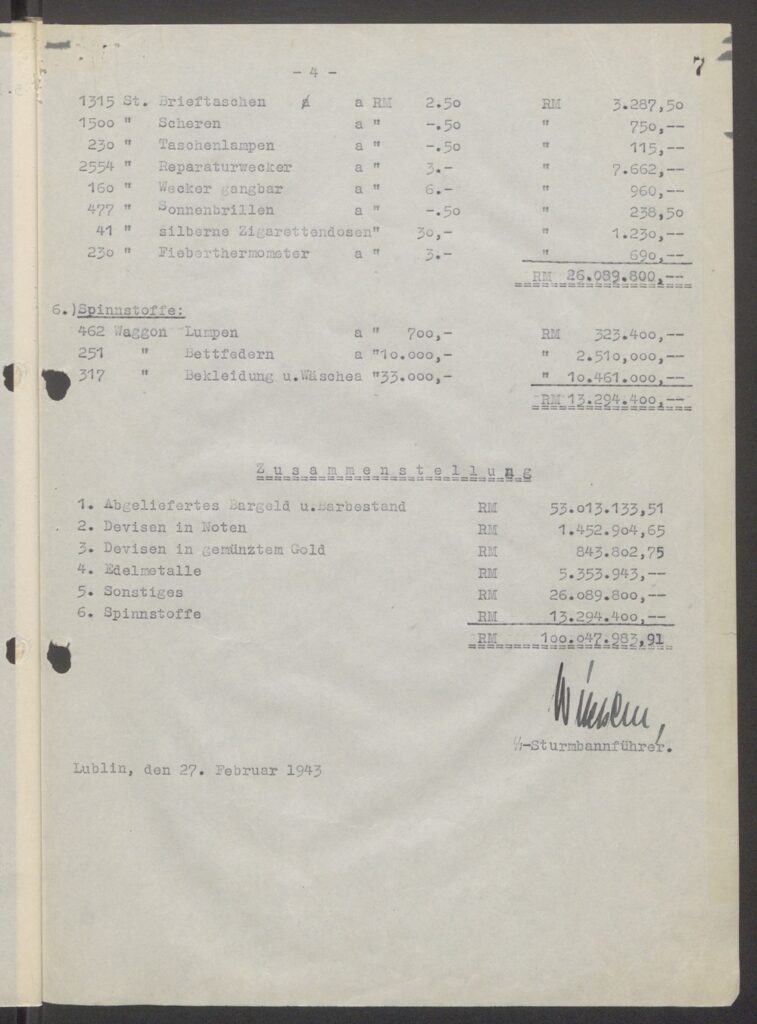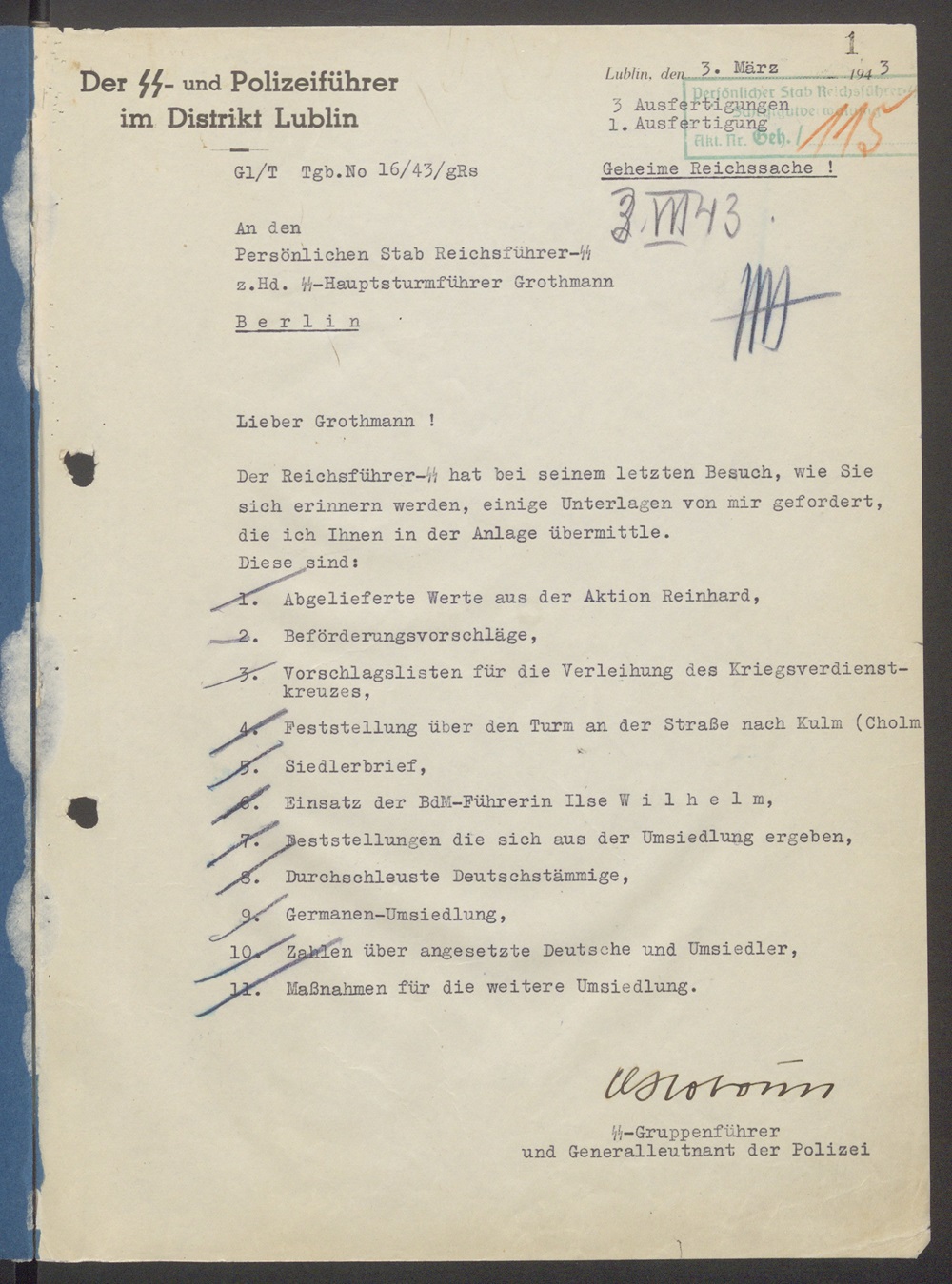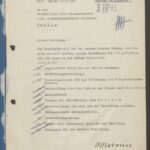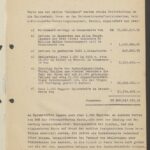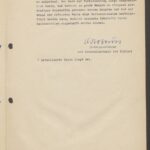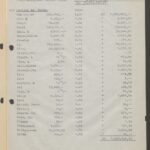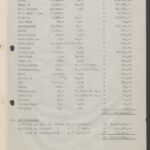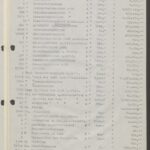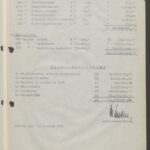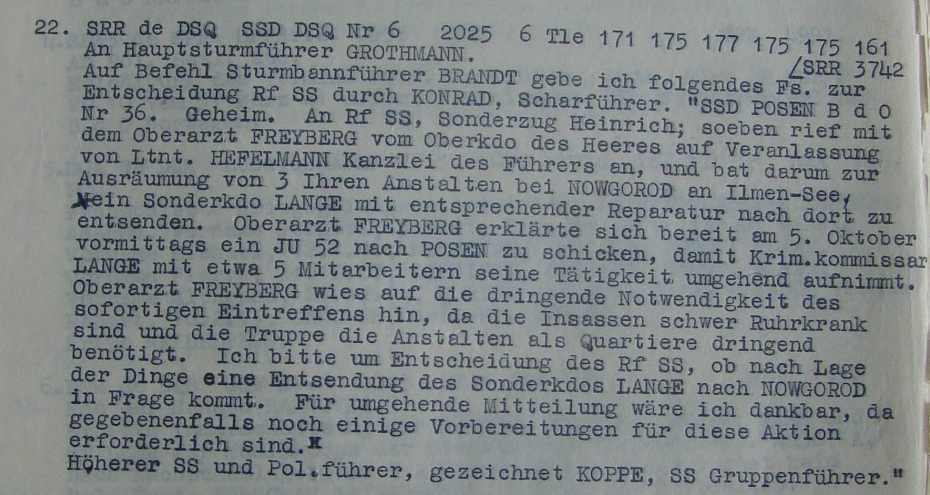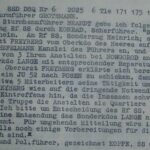Die Vorfälle in Kulmhof
In der zweiten Hälfte des M. Dezember 1941 und im Laufe des M. Jänner 1942 ereigneten sich im Dorfe Kulmhof Kreis Warthbrücken Fälle, welche an Greul und Barbarei alle bisherigen menschlichen Begriffe übertreffen.
Im Zeitlauf von etwa 4 Wochen vor der sogenannten Aussiedlung aus den gegebenen Judengemeinden wurde von den deutschen Behörden auf die gesamte jüdische Bevölkerung eine Kopfsteuer in der Höhe von RM 4.- auferlegt. Ausserdem wurden alle Juden (Männer von 14-60 und Frauen bis 50) einer ärztlichen Untersuchung unterzogen zwecks Feststellung ob sie arbeitseinsatzfähig sind, d.h. ob sie sich zur physischen Arbeit eignen. Diese Tatsachen beunruhigten ernstlich die Judenräte, jedoch alle Bemühungen zur Aufklärung des wahren Sinnes dieser Verordnungen haben fehlgeschlagen. Wohl hier und da sind ein deutscher Beamte oder SS Mann versichert, dass alle Juden aus dem Warthegau nach Pinsk, Galizien oder anderswo ausgesiedelt werden, aber diese Nachrichten trugen dem Charakter subjektiver Annahmen der Informateure ohne sich auf welche Daten zu stützen. Man schenkte dem keinen Glauben in der Meinung, dass nach 2-jährigen Bestehen des Warhegaus nach der Reduzierung bis zum Minimum der jüdischen Siedlungen, auf diese Angelegenheit niemand zurückkommen wird. Übrigens haben die schweren Lebensbedingungen der Juden im Warthegau und das Fehlen jeglichen Kontakts mit den massgebenden deutschen Stellen es verursacht, dass sämtliche Bemühungen erfolg- und zwecklos waren.
Die Juden des Kreises Kolo wussten lediglich von der Aussiedlung der Hinterberger Juden im Oktober 1941, welche sich auf ganz geheime Art vollzogen hat. In Hinterberg wurde die ganze jüdische Bevölkerung des Kreises Konin in der Zahl 8000 Seelen konzentriert. Die Amtshandlungen vor der Aussiedlung kamen vor ebenfalls in Hinterberg. Die Juden entrichteten die Kopfsteuer in der Höhe von RM 4.- und wurden ärztlich untersucht. Nach einer gewissen Zeit begann die Aussiedlung. In Partien zu je 60 Mann wurden die Juden in Lastautos weggeführt, wobei jeder nur 1 kg Paket mitnehmen durfte. Die Fahrt endete in den Kasimir-Wäldern in der Gegend vom Hinterberg. Dort stiegen alle aus und gingen in den Wald. Dann hörte man nichts mehr von ihnen. Sowohl Eilboten wie auch überall ins Reich und Generalgouvernement entsendete Briefe brachten nichts Neues. Die Tiefen der Kasimir-Wälder bargen das Geheimnis der Ausgesiedelten Hinteberger Juden.
Mitte Dezember 1941 wurde die ganze jüdische Bevölkerung aus Kolo (2000 Seelen) und Dombje a Ner (1000 Seelen) nach Kulmhof weggeführt. Die Aussiedlung umfasste wörtlich alle Juden. In Lastautos wurden Säuglinge, Kinder, Greise, Bettlägerige und alle übrigen mit dem ganzen Hab und Gut verladen und in Partien zu 60 Personen nach Kulmhof gebracht. Kulmhof ist ein auf der Strasse von Kolo nach Dombje a/ Ner ca 12 Kilometer von Kolo entferntes Dorf.
Die deutschen Behörden verbreiteten tendenziös Gerüchte, dass Kulmhof eine ausschließlich jüdische Siedlung im Kreis Kolo werden wird. Die Juden werden dort ihren Lebensunterhalt auf Grund produktiver Arbeit organisieren.
Das Schicksal der Juden aus Kolo und Dombje a/ Ner interessierte lebhaft die restlichen Gemeinden des Kreises Kolo. Die Juden aus Klodawa (1200 jüdische Einwohner), aus Izbica-Kuj. (1800 jüd. Einwohner), aus Bugaj (Bugitten, 800) und aus Sompolno (1000) glaubten richtig, dass auch sie dasselbe Schicksal erwartet. Um die Lebensbedingungen in Kulmhof genau kennenzulernen, entsendeten sämtliche Gemeinden polnische und deutsche Boten. Diese sollten konkrete Nachrichten über Kulmhof bringen. Die erhaltenen Nachrichten hatten gleichen Wortlaut: die Juden werden im Kulmhofer Schloss untergebracht, von wo sie nicht mehr herauskommen. Ins Schloss werden keine Lebensmittel gebracht. Die dortigen Bauern beobachten oft ein graues Lastauto, das mehrmals im Tage ins Schloss fährt und es verlässt und dann in die Lubrodzer Wälder fährt. Sie äusserten die Meinung, dass die Juden vergast werden. Man glaubte dem nicht und behandelte diese Nachrichten als ein Produkt bäuerlicher Phantasie. Das Leben floss weiter. Allein die Stimmung war sehr gedrückt- die Atmosphäre wurde dichter.
Am 2-ten und 4-ten Jänner 1942 wurden 46 Männer (30 und 16) aus Klodawa, am 6-ten und 9-ten Jänner 45 Männer (29 und 16) aus Izbica-Kuj. (Mühlental), am 9-ten Jänner 16 Männer aus Bugitten (Buhaj) genommen und nach Kulmhof weggeführt. In Bugitten lebten bereits 800 aus Kolo und Babjak ausgesiedelte Juden die dort musterhafte Landsiedlunge eingerichtet haben. Die Prozedur der früheren Einiehung der Kopfsteuer in der Höhe von 4 RM der ärztlichen Untersuchung der Juden und der Wegführung vorher einer gewissen Anzahl jüdischer Männer nach Kulmmhof betraf sowohl Warthbrücken und Dombje wie auch die oben erwähnten Städte.
Es unterliegt gar keinen Zweifel, dass die Aktion ideal vorbereitet und koordiniert war und die Ortsgendamerie von dem die jüdischen Bevölkerung erwartenden Schicksal genau benachrichtigt war. So haben z.B. in Izbica-Kuj. sämtliche Gendarmen darunter Ltnt. Johanne, Meister Plätzennieder und der volksdeutsche Gendarm Schmalz keinen Juden von der wahren Tatsache informiert, dagegen habe sie alle belogen und behauptet, dass ihnen von irgendwelcher Aussiedlung der Juden nichts bekannt ist.
Die früher weggeführten Juden erfüllten die Aufgaben der Gräber.
In der Zeit von 2-ten bis 9-ten Jänner wurden aus dem jüdischen Gheto in Lodz gebracht Zigeuner hingerichtet (manche glaubten, dass die Zigeuner politische Verbannte aus Jugoslawien sind). Am 10-ten und 12-ten Jänner wurden Juden aus Klodawa, am 13-ten Juden aus Bugaj, am 14-ten u. 15-ten Jänner Juden aus Izbica-Kuj. und vom 16-an Juden aus Lodz hingerichtet. Die erste Partie der nach Kulmhof “ausgesiedelten” Lodzer Juden zählte 750 Familien, ungefähr 3000 Seelen. Informateure (die am 15-ten Jänner aus Lodz nach Kulmhof gebrachten Gräber) geben an, dass die “Aussiedlung” der Juden aus Lodz 10.000 Personen erfassen soll.
Die Juden wurden in Lastautos, zuerst in Partien zu 60 , dann zu 90 Personen gebracht. Das Gepäck wurde in der Kirche, die links an der Strasse gelegen ist, abgelegt. Die rings um der Kirche befindlichen Gebäude wrden durch mundierte und nichtmunduierte Gestapo requiriert. Weiter links liegt das betreffende Dorf. Rechts von der Strasse, etwa 100 m entfernt, befindet sich das kulmhofer Schloss. Dort eben fuhr jedes Mal das Auto mit den Opfern vor. Beim Aussteigen aus dem Wagen war ein älterer, etwa 60-jähriger Deutsche behilflich und benahm sich gegen die Deliquenten sehr herzlich. Hielt die Säuglinge, damit die Mütter aus den Auto steigen können, den Alten und Kranken half er aus dem Wagen. Die Kranken stützten sich auf seinen Arm auf dem Wege ins Schloss. Durch sein herzliches Auftreten erwarb er sich die Sympathie und Vertrauen aller.
Das Schloss, von dem die Rede ist, ist ein altes einstöckiges Gebäude nach einem durch die Kriegshandlungen in den Jahren 1914-1918 vernichtetes Schlösschen. Einen düsteren Eindruck machte der Anblick der fehlenden Fensterscheiben. Das richtige Gebäude befindet sich im zweiten Hof. Der Raum, in dem man die Opfer gebracht hat, war ein grosses beheiztes Zimmer. Von dort führt eine Treppe hinunter ins Untergeschoss. Dort befindet sich ein Korridor, an dessen Ausgang eine Rampe aufgestellt wurde, zu der eine kleine Treppe führt. Im Untergeschoss befinden sich mehrere Kellerzimmer. Die Eingangstür führt in den ersten Hof und die zweite in den zweiten, den richtigen Schlosshof. Das ganze Schloss war durch starke Gendarmarie-Posten bewacht. Es waren dort zumindest 20 Gendarme. Gestapo, welche die ganze Aktion leitete, handelte nach einem präzis-ausgearbeiteten Plan. Das Grundprinzip der ganzen Aktion war vollständige Diskretion. Die Einzelnen Teile waren derart perfekt zusammengestellt, dass nicht ein Mal kam es vor, dass sich 2 Gruppen der “ausgesiedelten” zusammengetroffen hätten.
Ein SS-Offizier und der erwähnte 60 jährige hielten an die Versammelten Ansprachen. Sie erklärten, dass alle Versammelten nach Litzmannstadt Ghetto fahren werden, wo die Männer in Fabriken und Shops beschäftigt werden und die Frauen werden sich mit Hauswirtschaft befassen und die Kinder werden in die Schule gehen. Vor der Abreise nach Lodz müssen aber die Juden in speziell eingerichteten Schwitzbad, wo auch ihre Sachen desinfiziert werden. Alle müssen sich ausziehen, die Männer bleiben in Hemden und Unterhosen, die Frauen in Hemden. Ausweise und Wertgegenstände sollen in einem Tuch aufbewahrt werden. Das in der Kleidung eingenähte Geld soll herausgenommen werden, damit es im Desinfektor nicht vernichtet wird.
Nach dieser Vorbereitung der Versammelten wurde die Tür geöffnet und durch eine kleine Treppe die hinunter führte wurden sie höflich aufgefordert ins Bad zu gehen. Nach dem Verlassen des Zimmers fiel stark die Temperatur, da es draussen ein starker Frost herrschte und der Korridor gänzlich unbeheizt war. Auf die Klagen der Versammelten antwortete der 60-jährige Deutsche und der SS-Offizier auf höfliche und herzliche Art, sie mögen ein wenig Geduld haben, bis sie in dem Baderaum kommen. Der “Baderaum” war eben die Rampe, auf die man die Opfer mit Peitschen und Stöcken gejagt hat und von wo sie in das Gasauto das an der zweiten Seite der Rampe untergebracht war, verladen wurden. Die Herzlichkeit und Höflichkeit schwanden. Eine unbeschreibliche Verzweiflung und wilder Schrecken packte die Unglücklichen. Sie schrieen und weinten und beteten laut. Der Wagen, in den die Opfer hineingejagt wurden (es war derer zwei) war ungefähr so groß wie ein grosses Lastauto. Grau, hermetisch abgesperrt, hatte gut zugepasste Türen mit einem Aussenriegel versehen. Innen war keine Sitzplätze. Die Wände waren mit Blech beschlagen, der Fußboden mit Strohmatten auf hölzerne Leisten ausgelegt. Unter den Leisten, zu beiden Seiten des Wagens, waren zwei 15-cm breite Gasröhren untergebracht. Beide Röhren , der Öffnungen sich im Innern des Wagens befanden, führten in den Fahrerraum wo sie mit einer Gasleitung verbunden waren, welche mit mehreren Knöpfen versehen war.
Nachdem alle verladen waren und das Auto hermetisch abgesperrt war fuhr der Wagen durch die beiden Schlosstore in den 7 km in der Richtung Kolo entfernten Wald. Die Fahrt dauerte 15 Minuten. Links von der Strasse führte ein halb-kilometerlanger glattgemachter Weg und wieder links davon nach ungf. 200 meter Fahrt sah man den Standplatz. Es war dies ein Wiesenplatz umstellt mit Gendarmen mit schiessbereiten Hand Maschinengewehren. Entlang des Platzes zog sich im Rechteck ein Graben bis zum Weg der zum Platz führte.
Der Graben vielmehr das gemeinsame Grab der vergasten Opfer war unten 1,5 Meter und oben 5 Meter breit. Die Tiefe betrug 5 Meter.
Am Platz drehten sich die Gräber ind Zahl von ung. 20-50, und durchschnittlich 30 Gendarmen und S.S. Männer und civile Gestapo. Ein Teil der Gräber war mit dem aufgraben des durch den Frost hartgewordenen Bodens, ein anderer Teil wieder bei den Leichen. Die Gräber sowohl die im Mannesalter wie auch 15 jährige Jungs und 60 Jährige Greise arbeiteten nur dürftig gekleidet u.z. in Hosen Unterhosen Hemden und Stiefeln. Andere Garderobeteile mussten sie ablegen.
Der Wagen blieb ungefähr 100 Meter vom Grab stehen. Der Fahrer und Henker in einer Person drückte auf die Knöpfe des Gasaparates der im Fahrerraum montiert war und ging hinaus. Die Fahrer der beiden Hinrichtungswagen waren wie gesagt gleichzeitig die Henker. Es waren dies SS-Männer mit dem Totenkopf auf den Mützen. Auf dem Wagen drängte ein gedämpftes Geschrei, Lärmen und Weinen und Klopfen in die Wände. Nach einer gew. Zeit (etwa einer Viertelstunde) war alles wieder still. Dann stieg der Fahrer und Henker wieder in den Fahrerraum und schaute mit Hilfe einer elektrischen Taschenlampe in das Innere der Gaskammer (Wageninnere) um festzustellen ob der Tod eingetreten ist. Zwischen der Gaskammer und dem Fahrerraum waren 2 Scheiben. Nachdem er festgestellt hat dass der Tod eingetreten ist fuhr er näher zum Grab. Dann wartete er 5 Minuten wonach der sog. SS Platzoffizier der sich durch eine unbegreifliche Barbarei und Sadismus auszeichnete den Befehl gab die Türe des Wagens zu öffnen. Es schlug ein starker Gas Geruch. Nach weiteren 5 Minuten schrie der Offizier: “Juden geht Tefilin legen das hiess schmeisst die Leichen heraus. Diese Arbeit verrichteten 8 Juden von denen 4 die Leichen aus dem Wagen holten 2 warfen sie ins Grab und 2 legten sie dort zurecht. Die Leichen im Wagen waren in einem schrecklichen Durcheinander, beinahe alle waren mit Kot beschmutzt wahrscheinlich von Schreck oder durch die Wirkung des Gases. Die Toten behielten aber die natürliche Hautfarbe und sahen eher aus wie im Schlaf. Das Hinauswerfen der Leichen vom Wagen geschah schnell und brutal. Der Offizier schrie und schlug mit der Peitsche. Frauenleichen wurden bei den Haaren die anderen bei den Händen und Füßen gepackt und so auf einen Haufen geworfen. Dann haben 2 Deutsche in zivil die Leichen speziell genau untersucht um ihnen die Wertsachen abzunehmen. Die Prozedur sah mehr weniger so aus. Aus dem Haufen nahm man der Reihe nach je eine Leiche und untersuchte sie genau. Die Halsketten wurden heruntergerissen die Eheringe von den Fingern heruntergezogen, die Goldkronen aus dem Mund gerissen. Es wurde genau nachgesehen, ob nicht Wertsachen und Gold im After oder den weiblichen Organen verborgen liegen. Diese Prozedur rief unter den terrorisierten Gräbern einen wahren Schrecken und Wutanfall hervor. Die Zigeuner wurden zum Unterschied von den Juden im Gasauto mitsamt ihren Hab sogar mit den Wertsachen untergebracht und nach erfolgter Hinrichtung zusammen bestattet. Dann wurden die geschändeten und beraubten Leichen in dem Grab geworfen. Diese Arbeit verrichteten 2. hierzu speziell gewählten Juden. 2 andere jüdische Gräber arbeiten im Grab selbst unter den Befehl eines SS-Mannes welcher mit Hilfe eines Zweiges, oben stehend die Arbeit leitete und zeigte, wie die Leichen gelegt werden sollen. Diese wurden mit dem Gesicht zum Boden gelegt – neben dem Kopfe der einen lagen die Beine der anderen. Im Freiraum legte man die Säuglinge, Kinder und bei den Zigeunern das Hab und Gut.
Nach dem Entleeren wurde der Wagen von menschlichen Kot und anderen Unsauberkeiten gereinigt, dann fuhr er fort.
Täglich wurden 6-9 Transporte beerdigt. Eine Schicht zählte bis 200 Leichen. Jede Schicht wurde mit Erde zugeschüttet und ab 17. Jänner schüttete man noch Chlorkalk darüber um den üblen faulen Geruch zu beseitigen.
Der Kulmhofer Wald wo diese massenhafte, unheimliche Hinrichtung stattfand, war dicht mit Gendarmarieposten besetzt. Es ging darum, die absolute Sicherheit zu gewinnen, dass das schreckliche Geheimnis des höllischen Mordens ganzer jüdischer Siedlungen nicht entdeckt werden. Die am Mordplatz tätigen Gendarmen hatten die Aufgabe die Gräber bei jedem Ortswechsel (vom Grab zum Wagen, zum Mittagessen) zu hüten und ihnen fortwährend mit den HMG zu drohen.
Die Gräber sassen im Schloss in 2 anschliessenden Kellern. Der Tag begann um 7 Uhr früh. Der zivile deutsche Koch brachte den Eimer mit dem Frühstück. Es bestand aus einen bitteren lauen schwarzen Kaffee und trockenen Brot, das aus dem Gepäck der jüdischen Opfer stammte. Nach dem Frühstück meldete der diensthabende Gendarm dem SS Offizier. Dann öffnete er die 3-fach geschlossene Tür, es kam der Befehl: Juden raus! Nicht ein einziges mal kam es vor dass der SS-Offizier in Keller stieg, denn er fürchtete die verzweifelten, desperaten Gräber, die vom Hass gegen die Henker erfüllt waren. Beim Verlassen des Kellers wurden die Gräber mehrmals gezählt. Jede Partie wurde in den Hof geführt. Der Hof war mit 20 Mann starken Feldgendarmie-Posten bestellt, mit HMG gegen die Versammelten gerichtet. Nach neuerlichen Zählen der Gräber wurden sie im Auto verladen. Zwei Wagen, ein Lastauto und eine Autokarre führten sie zum Hinrichtungsplatz. Hinter dem Wagen fuhr eine Limousine mit mund. und nichtmund. Gestapo.
In der Zeit der kurzen Jännertage, wenn man um 8 Uhr früh hinausfuhr, war es noch finster, so dass man noch keinem Fremden begegnete.
Die Arbeit am Hinrichtungsplatz begann gegen 8.30 früh und dauerte bis Mittag, d.h. 12.30. Es fiel der Befehl: Spaten stehen lassen! Die Gräber verließen den Graben und eskortiert von SS Männern und Gendarme begaben sich zum Ort, wo sich ihre Kleidung befande. Dort befahl man ihnen sich zusammenzudrücken und sich am Gepäck hinsetzen. Das Mittagessen bestand wieder aus bitterem Kaffe, kalten schwarzen Kaffee und hartem gefroren Brot.
8 Gräber, die unmittelbar bei den Leichen beschäftigt waren, durften das Grab nicht verlassen. Dorthin wurde ihnen der Kaffee ohne Brot gereicht. Vor dem Beenden des Arbeitstages befahl man ihnen, sich in das Grab mit den Gesicht zu den Leichen gewendet zu legen und ein SS Mann durchlöcherte ihnen die Köpfe mit dem HMG. Die übrigen schütteten das Grab zu und begaben sich eiligst unter Eskorte der Gendarme auf dem Sammelplatz. Mehrmals wurde ihre Zahl kontrolliert. Nach dem Befehl: – Juden anziehen! – zogen sich alle an. Grundsätzlich endete der Arbeitstag um 5 Uhr. Es waren jedoch Tage, besonders beim Hinrichten der Lodzer Juden, dass bis zum späten Abend bei Scheinwerferlicht gearbeitet wurde.
Während der Arbeit im Grab verrichteten die Gräber oft das Gebet für die Gestorbenen, das s,g. Kadisch. Die Arbeiter mussten oft zusehen, wie ihre nahem Verwandten in das Grab geworfen wurden.
Jede Erscheinung der Ermüdung wurde mit harten Prügeln am nackten Körper oder mit dem Tod bestraft.
Der Platz-Offizier war oft betrunken und in der Folge hatte er die Arbeiter noch barbarischer und herzloser geprügelt.
Beinahe jeden Tag kamen SS-Offiziere in Autos um die “Arbeit” mitanzusehen. Mit sichtlicher Befriedigung schauten sie der Hinrichtung zu und drückten dann dem Platz-Offizier mit Anerkennung die Hand.
Folgender Vorfall fand am 13. Jänner statt: nach dem Hinauswerfen der Leichen aus der Gaskammer stellte es sich heraus, dass ein Säugling aus Bugitten in ein Polster gehüllt durch einen wunderlichen Zufall nicht vergast wurde. Es begann zu weinen, aber ein Schuss aus dem MG in das Köpfchen des Kindes machte das wunderbar-gewonne Leben des Säuglings ein Ende. Die Nazi-Gerechtigkeit war befriedigt.
Im Schlosskeller war es kalt und düster. Am Boden lag in Unordnung das Kleidungsgepäck der Gräber. Die Hände mit Eis bedeckt. Im Winkel brannte eine kleine Petroleumlaterne. Im zweiten stand ein Latrineeimer. DIe Nerven der noch lebenden Opfer waren derart zerrüttet dass das Weinen erwachsener Männer war eine natürliche Erscheinung. Die einen hielt noch der Selbsterhaltungstrieb, die anderen unterlagen gänzlich der Verzweiflung und begingen Selbstmord. Über alles aber wollten alle aus der Falle hinaus, um die noch bestehenden jüdischen Gemeinden und die ganze Welt von den schrecklichen Geschehnissen in den Kulmhofer Wald zu alarmieren.
Es kam noch vor, dass der Wächter verlangte, dass die Juden singen. Es half kein Flehen und Bitten. Das MG zwang sie zum Gehorchen. Man sang Fragmente des Gebetes “Schma Israel” und das Nationallied “Hatikwa” (Die Hoffnung). Alle fühlte sich wie vor dem Gottesgericht. Der Ernst und völlige Gleichgültigkeit zu den irdischen Angelegenheiten und Leidenschaften erfüllten ihr Dasein. Doch war das dem brutalen Wächter zu wenig. Die Juden mussten laut den von ihm gesprochenen Satz wiederholen: “Wir Juden danken Adolf Hitler für diese Sache” und dann “Wir Juden danken Adolf Hitler für das Essen.”
Die Richtigkeit der obigen Beschreibung unterliegt keinen Zweifel. Sie stützt sich auf sicheres Quellenmaterial.
